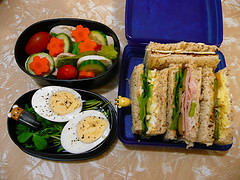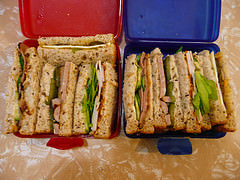Bento tips and reflections #1
I’ve been making bento lunches for a few weeks now, and I’m still enjoying it. I thought I’d answer some of the questions that readers have been asking me via a series of blog posts. Here’s the first.
I know strictly speaking, sandwiches probably aren’t bento food, but sandwiches are one of Jac’s all-time favourite foods, and I do like sandwiches and salad in a bento-style lunch. A few people have asked me how I keep sandwiches from going soggy. Here are my tips. I don’t intend for these to be universal sandwich-making rules; they’re just what I do. If any of you have more tips to share, please feel free, as I’m sure others reading them will appreciate it!


How to keep sandwiches from getting soggy
- Make the sandwiches as close to eating time as possible.
Of course, on weekdays it’s simply not possible to make the sandwiches close to eating time. But I do make my sandwiches in the morning rather than the night before. Not only are they fresher, there’s less time for the sandwiches to get soggy. - Don’t use sandwich-cut bread – use toast-cut bread.
I’ll start off by saying that some people may simply prefer sandwich bread as it’s not as thick as toast bread – they may prefer a less “bready” sandwich. I’m used to eating toast-cut bread, so I don’t find it extra bready at all. On a practical level, we’ve found the thicker bread results in a less soggy sandwich – if there’s any excess moisture, it’s going to take that much longer to soak through the bread (if at all, if you take precautions to prevent sogginess). Also, we’ve found that the thicker bread is more robust and is less likely to break or get bent out of shape from generous amounts of fillings, which we like in our sandwiches. - I never put fresh tomato in a sandwich.
I do love fresh tomato, but unfortunately, tomato is probably the fastest sandwich soggifier there is. Some people will suggest you remove the wettest part of the tomato – the middle bit with all the seeds – which can help. I lot of people pack the tomato separately to the rest of the sandwich, and then add it to the sandwich at lunch time before eating. Personally, I only want to make my sandwiches once, so I never bother with packing separate tomato. I make my sandwiches without tomato, and, if I want to eat tomatoes, include them in the salad that I’ll be eating with the sandwiches. - Make sure all vegetables are as dry as possible before using them.
I wipe pickles, cucumber and lettuce dry with a bit of paper towel before putting them in the sandwiches. I use a salad spinner to dry my washed lettuce, but I still wipe the leaves dry before placing them in a sandwich. - Use spreads as a protective barrier against moisture.
If you’re concerned about calories, don’t use your spreads too thickly, as spreads can often contain a lot of sugar. The trick is to spread it evenly, which will form a protective layer and actually prevent the bread from getting soggy from the other fillings. Butter, margarine, peanut butter, Vegemite, hummus, cream cheese, mustard, chutney, jam, mayonnaise are all good for this. Lettuce can also be a fantastic protective barrier, but of course it must be dry to begin with (see point 4). - Don’t use runny sauces or dressings.
Runny sauces or dressings are more likely to soak through bread than thick spreads, and they can make your veggies (salad, cucumber etc) wilt or go soggy a lot quicker. - Don’t use hot or warm ingredients in a sandwich that you’re planning to pack to eat later.
Let cooked fillings cool down completely before putting them in the sandwiches.
I love a hot fried egg sandwich with loads of tomato sauce (also see point 6 about runny sauces), but that’s the kind of sandwich I’ll buy or prepare to eat right away. - Put the drier fillings next to the bread, wetter fillings in the centre.
Generally speaking, I don’t tend to use very wet fillings, other than spreads like chutney, relish, mustard etc, but they don’t tend to make the toast-cut bread soggy, so it’s all good.
Examples from my recent sandwiches
(B) = Barrier
Bread
Margarine (B)
Hard-boiled egg mixed with mayonnaise and French mustard
Thinly sliced cucumber (washed and wiped dry)
Shredded cos lettuce (washed and wiped dry) (B)
Bread
Bread
Dijon mustard (B)
Cos lettuce (washed and wiped dry)
Sliced sour gherkins (washed and wiped dry)
Ham
Mayo (B)
Bread
Bread
Corn relish (B)
Sweet pickles (washed and wiped dry)
Tasty cheddar (B)
Bread
Bread
Margarine (B)
Cucumber (washed and wiped dry)
Roast beef
Indian-style mango chutney (B)
Bread
Coming up soon
The next “bento tips and reflections” post will be about preventing bento box leakage.